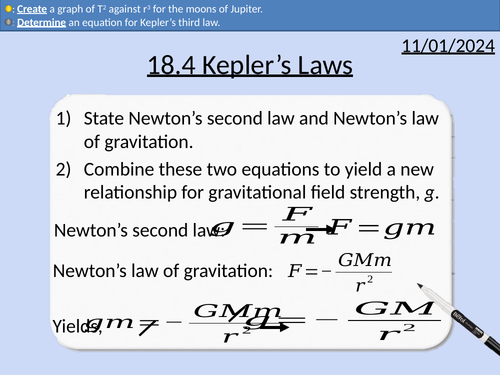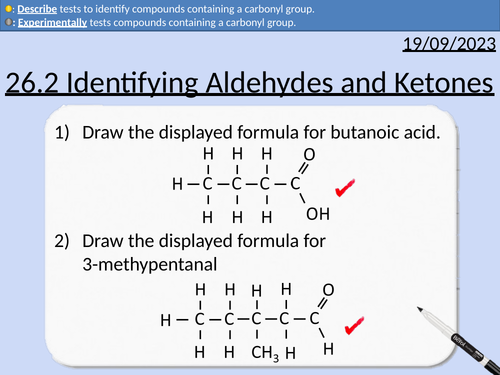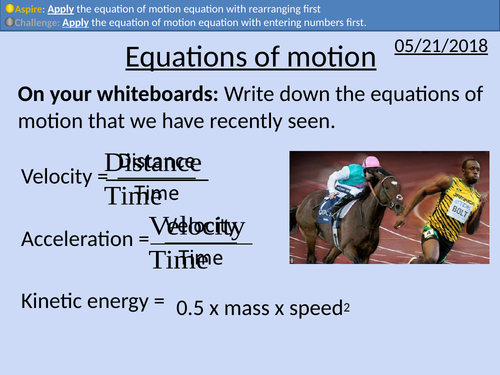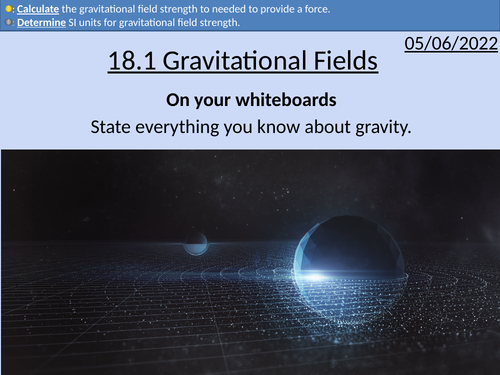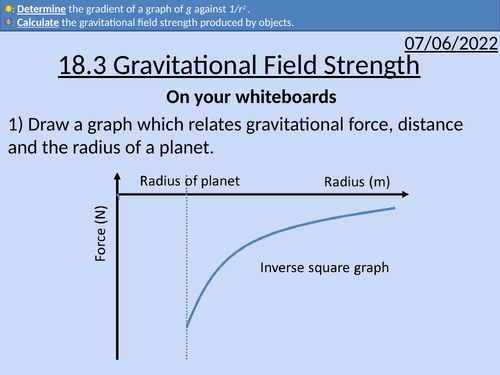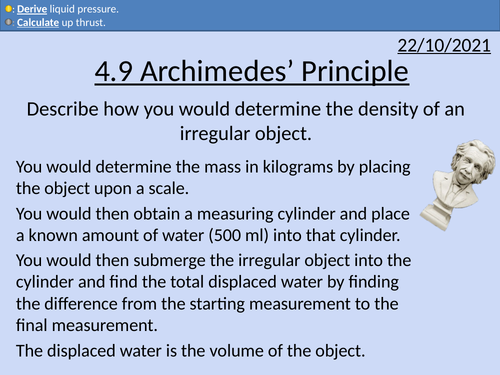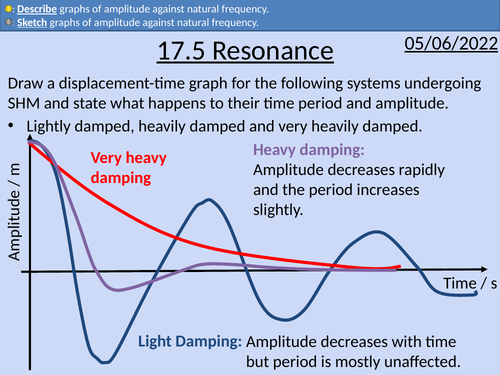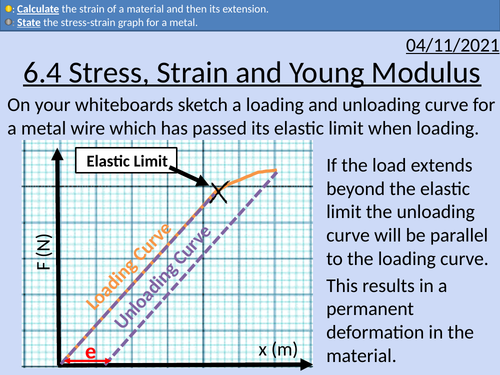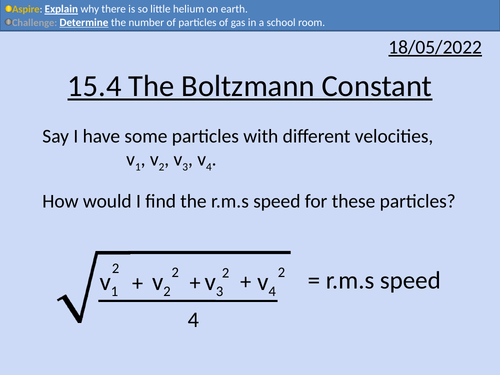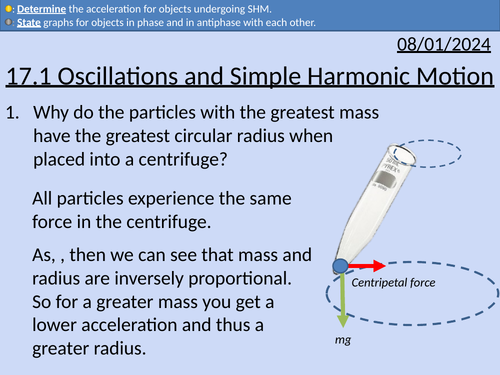449Uploads
137k+Views
61k+Downloads
All resources

OCR A Level Physics: Gravitational Potential
OCR A level Physics: 18.6 Gravitational Potential
Module 5 Newtonian World and Astrophysics
This PowerPoint is a whole lesson included with student activities, animated answers, homework questions with answers provided.
This lesson covers:
Center of mass and treating spherical objects as point masses
Gravitational fields
Definition of gravitational potential
Applying the gravitational potential equation
Graph of gravitational potential against distance (V against r)
Combining gravitational potentials from more than one mass

OCR A Level Physics: Satellites
OCR A level Physics: 18.5 Satellites
Module 5 Newtonian World and Astrophysics
This PowerPoint is a whole lesson included with student activities, animated answers, homework questions with answers provided.
This lesson covers:
Key features of geostationary and low polar orbit satellites
Conditions for stable orbits for satellites
Applying Kepler’s laws to the orbits of satellites

OCR A Level Physics: Kepler’s Laws
OCR A level Physics: 18.4 Kepler’s Laws
This PowerPoint is a whole lesson included with student activities, animated answers, homework questions with answers provided.
This lesson covers:
The terms: eccentricity, aphelion, perihelion, astronomical unit
Kepler’s First Law
Kepler’s Second Law
Kepler’s Third Law
Graphs of T^2 against r^3 to determine the gradient (constant of proportionality, k).
Equating (4π)^2/𝐺𝑀 to the gradient (constant of proportionality, k)

OCR Applied Science: 2.1 Mixtures and Alloys
This PowerPoint presentation with worked examples and student activities covers:
Topic 2.1 of Science Fundementals of the OCR Applied Science Spec.
Types of mixtures to include solutions, colloids and suspensions
Difference between colloids and suspensions in terms of particle size
Uses of common colloids in nature and medicine
Types of colloids to include aerosols, emulsions, foams, gels and sols
Significance of colloids in nature and medicine
Alloys as mixtures of metals
The character and features of alloys
Uses of common alloys to include amalgam, solder, bronze, titanium alloy

A level Chemistry: Identifying Aldehydes and Ketones
OCR A level Chemistry: 26.2 Identifying Aldehydes and Ketones
This PowerPoint is a whole lesson included with student activities, animated answers, homework questions with answers provided.
This lesson covers:
Testing for Carbonyl Groups
Brady’s reagent - 2,4-dinitrophenylhydrazine - 2,4-DNP
Distinguishing between Aldehydes and Ketones
Tollen’s reagent - silver nitrate in aqueous ammonia

GCSE Physics: Equations of Motion
This presentation covers GCSE Physics OCR Gateway P2.1.6
Introduction of final speed^2 – initial speed^2 = 2 x acceleration x distance
Rearranging of final speed^2 – initial speed^2 = 2 x acceleration x distance
Derivation of final speed^2 – initial speed^2 = 2 x acceleration x distance
Three different methods for rearranging equations
Kinetic energy, acceleration and speed problems with answers

A level Chemistry: Proton NMR Spectroscopy
OCR A level Chemistry: 29.4 Proton NMR Spectroscopy
This PowerPoint is a whole lesson included with student activities, animated answers, homework questions with answers provided.
This lesson covers:
Identifying the number of different proton environments
Identifying the types of proton environment and chemical shifts
Integration traces (area of peaks) and relative number of protons
The spin-spin splitting pattern (n + 1)

A level Chemistry: Interpreting Proton NMR Spectra
OCR A level Chemistry: 29.5 Interpreting Proton NMR Spectra
This PowerPoint is a whole lesson included with student activities, animated answers, homework questions with answers provided.
This lesson covers:
Predicting proton NMR spectra for molecules
Identifying the number of different proton environments
Identifying the types of proton environment and chemical shifts
Integration traces (area of peaks) and relative number of protons
The spin-spin splitting pattern (n + 1)

OCR A Level Physics: Gravitational Fields
OCR A Level Physics: Gravitational Fields presentation, homework and answers.

A level Chemistry: Nuclear Magnetic Resonance (NMR) Spectroscopy
OCR A level Chemistry: 29.2 Nuclear Magnetic Resonance (NMR) Spectroscopy
This PowerPoint is a whole lesson included with student activities, animated answers, homework questions with answers provided.
This lesson covers:
Nuclear Spin
Resonance
Tetramethylsilane (TMS)
Chemical Shift ẟ

OCR A Level Physics: Simple Harmonic Motion and Energy
OCR A Level Physics: Energy and Simple Harmonic Motion presentation with homework and answers

OCR A Level Physics: Gravitational Field Strength
OCR A Level Physics: Gravitational Field Strength presentation with homework and answers

OCR AS level Physics: Archimedes' Principle
OCR AS level Physics: Archimedes’ Principle is a part of the Module 3: Forces and Motion
Presentation come with worked examples, solutions and homeworks.

GCSE Physics: Series and Parallel Circuits
This presentation covers OCR Gateway Physics 9-1 P3.2.2 Series and Parallel Circuits
Rule for current in series and parallel circuits
Rule for potential difference in series and parallel circuits.
Working scientifically
Student activities with worked solutions
Exam questions with worked solutions

A level Chemistry: Carbon-13 NMR Spectroscopy
OCR A level Chemistry: 29.3 Carbon-13 NMR Spectroscopyy
This PowerPoint is a whole lesson included with student activities, animated answers, homework questions with answers provided.
This lesson covers:
Identifying different carbon environments
The types of carbon environment
The amount of chemical shift ẟ / ppm

OCR AS level Physics: Stress, Strain, &Young Modulus
OCR AS level Physics: Stress, Strain and Young Modulus is a part of the Module 3: Materials. Presentations come with worked examples, solutions and homeworks.

OCR A Level Physics: The Boltzmann constant
OCR A Level Physics: The Boltzmann constant presentation with homework and answers

OCR A Level Physics: Analysing Simple Harmonic Motion
OCR A Level Physics: Analysing Simple Harmonic Motion presentation with homework and answers.

OCR A Level Physics: Simple Harmonic Motion and Oscillations
OCR A Level Physics: Simple Harmonic Motion and Oscillations presentation, homework and answers.



